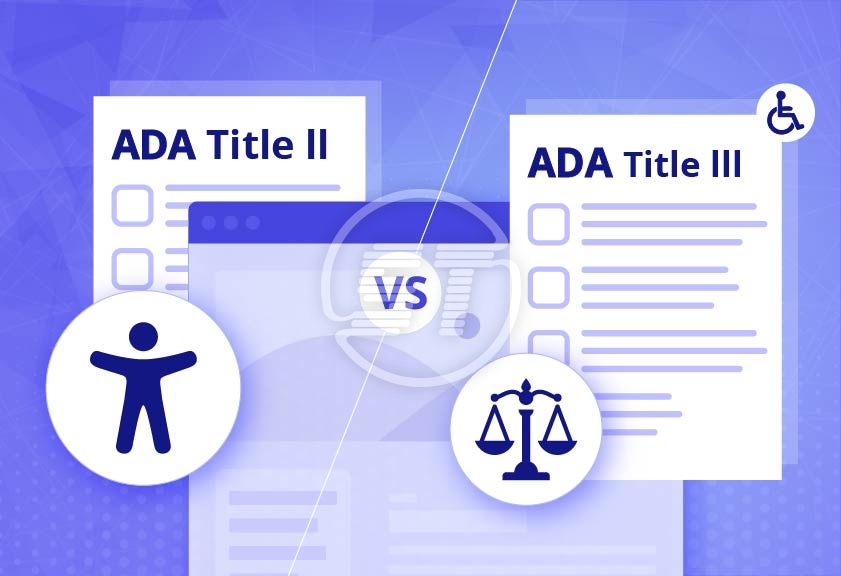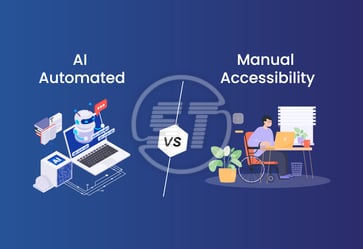The Americans with Disabilities Act (ADA) is one of the most significant civil rights laws in the United States. Signed into law in 1990, it was designed to ensure that people with disabilities have the same rights and opportunities as everyone else. However, when businesses, governments, and organizations delve into ADA compliance, they often encounter two critical sections: Title II and Title III.
Both play a major role in creating equal access and they apply to very different entities. If it is confusing, “Which one applies to an organization?” or “Does a business need to comply with both?”, this article will help.
ADA framework: Its outline!
The ADA is divided into five titles, each focusing on different aspects of public life - from employment to education, telecommunication to entertainment, and banking to various businesses. Among these, Title II and Title III are the most relevant for public entities, businesses, and organizations because they directly deal with accessibility in services and facilities.
ADA Title II: What does it say?
ADA Title II applies to state and local governments, as well as public entities. This refers that any department, agency, or program operated by a government body must be accessible to individuals with disabilities.
The law applies to:
- Public schools and universities
- State and city government offices
- Public transportation systems
- Public libraries and courthouses
- Municipal programs (like community centers, voting, recreation, etc.)
Key requirements of Title II:
- Program accessibility: All services, activities, and programs must be accessible - not just physical infrastructure but also digital platforms and communication.
- Communication access: Governments must provide auxiliary aids and services, such as sign language interpreters, captioning, or accessible documents.
- Policy modifications: Rules and practices must be adjusted if they create barriers (for example, allowing service animals in a municipal building).
- Digital accessibility: Websites, apps, and online portals run by state or local governments are considered part of public services and must comply with accessibility standards.
Example: If a city launches an online platform for residents to pay taxes, it must be screen reader-friendly and usable by people with visual or cognitive disabilities.
ADA Title III: What it covers?
Title III applies to private businesses and non-profit organizations that are considered “public accommodations”. This covers a broad range of places where the public engages in goods, services, or activities.
The law applies to:
- Restaurants, hotels, and retail stores
- Theaters, stadiums, and convention centers
- Banks and healthcare facilities
- Private schools and daycare centers
- Online businesses (ecommerce websites, apps, and digital platforms)
Key requirements of Title III:
- Physical accessibility: Buildings and facilities must be accessible, including entrances, restrooms, and seating.
- Barrier removal: Businesses must remove architectural and communication barriers when it is “readily achievable”.
- Equal access to services: Customers with disabilities must be able to participate fully in goods and services offered.
- Website accessibility: Courts increasingly interpret Title III to include online spaces, requiring businesses to make websites accessible.
Example: A restaurant must provide wheelchair-accessible entrances and also ensure its online ordering platform is accessible to screen readers.
Title II vs Title III: The key differences
| Aspect | Title II (Public Entities) | Title III (Private Businesses) |
|---|---|---|
| Who it applies to | State & local governments, public transportation, public programs | Private businesses, non-profits, and public accommodations |
| Focus | Accessibility of government programs, services, and activities | Accessibility of private goods, services, and facilities |
| Digital accessibility | Required for government websites, apps, digital services | Increasingly required for websites, ecommerce, and online services |
| Examples | City hall, DMV, public school website, transit system | Shopping mall, hotel, online store, and private hospital |
| Enforcement | U.S. Department of Justice (DOJ), Federal agencies | U.S. Department of Justice (DOJ), private lawsuits |
Why does the distinction matter?
Understanding whether ADA Title II or Title III applies is critical for compliance.
- A city government cannot simply say its voting website is “good enough” - it must be fully accessible.
- A business owner can’t ignore accessibility by claiming it’s “too expensive” if barrier removal is “readily achievable”.
Noncompliance can lead to lawsuits, financial penalties, reputational harm, and - most importantly - exclusion of individuals with disabilities.
Where ADA Title II and Title III overlap?
Though distinct, Titles II and III share a common goal: ensuring accessibility for all. Both require:
- Eliminating barriers (physical, digital, or communication-based)
- Modifying policies to accommodate individuals with disabilities.
- Providing equal opportunities in participation.
In many cases, digital accessibility is where the two converge. Whether a state-run online portal or a private ecommerce site, the digital spaces must be usable for people with disabilities.
Also read: ADA Title II accessibility compliance
In a nutshell,
The ADA was never about simply checking legal boxes – it’s about opening doors (literally and figuratively) for millions of Americans with disabilities.
- ADA Title II ensures government programs and services are accessible.
- ADA Title III ensures businesses and public accommodations welcome everyone equally.
Whether running a government agency or a private business, accessibility is no longer optional - it’s a responsibility, a legal obligation, and a step toward creating a more inclusive society.
Understanding ADA Title II and Title III is just the first step - putting accessibility into action is where we can help. Our team specializes in manual accessibility audits, remediation, ongoing compliance support, VPAT / ACR tailored to your needs. Reach out hello@skynettechnologies.com or request a quote to reduce legal risks, improve user experience, and build a truly inclusive digital presence.


